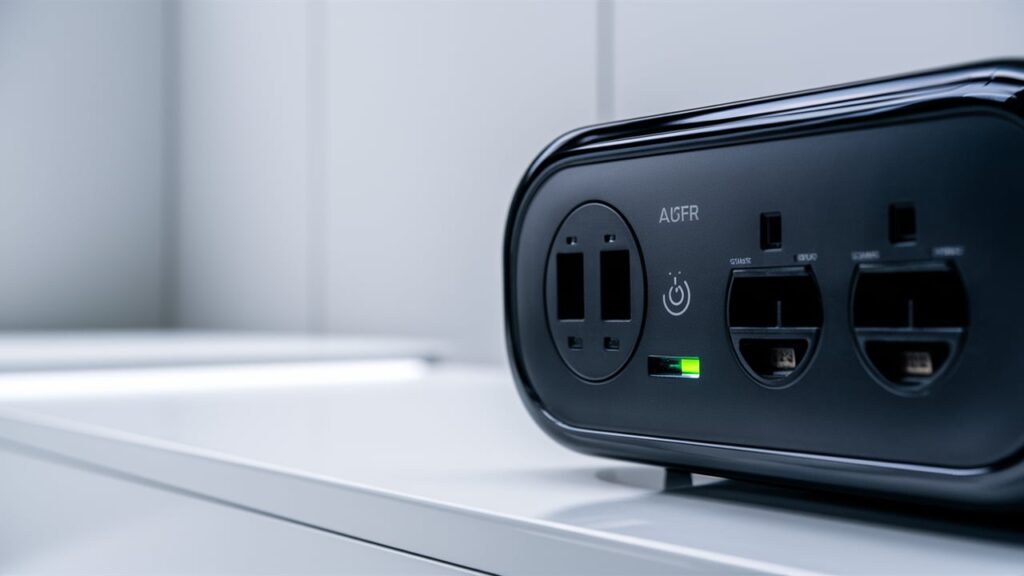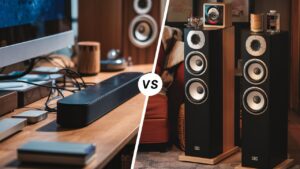A surge protector works by using a metal oxide varistor (MOV) to absorb excess voltage and divert the excess current to the ground. This device acts as a shunt resistor to protect connected devices from power surges and spikes.
Surge protectors are designed to handle slight fluctuations in voltage, but they have limitations and may fail if exposed to higher voltages. While basic surge protectors can handle small fluctuations, higher voltage surge protectors are available at a higher cost.
It is important to follow the manufacturer’s recommendation and not leave surge protectors plugged in all the time. Surge protectors provide an essential layer of protection for electronic devices by preventing damage caused by power surges.

The Vital Role Of Surge Protectors
Surge protectors play a vital role in safeguarding our electronic devices from the damaging effects of power surges. Understanding the protection mechanisms and the importance of surge protectors in device safety is crucial for ensuring the longevity of our valuable equipment.
Protection Mechanisms
Surge protectors utilize various protection mechanisms to shield electronic devices from power surges. The most common mechanism is the implementation of metal oxide varistors (MOVs) within the surge protector. MOVs function to absorb excess voltage and act as shunt resistors to divert the surplus energy away from the connected devices.
Importance In Device Safety
The significance of surge protectors in device safety cannot be overstated. By promptly mitigating power surges, surge protectors prevent the costly and potentially irreversible damage that these surges can inflict on sensitive electronic equipment. Investing in high-quality surge protectors is essential for ensuring the safety and longevity of our electronic devices.
Understanding Electrical Surges
Understanding Electrical Surges: Surge protectors, such as metal oxide varistors (MOVs), are designed to absorb excess voltage and divert the current to the ground. They provide protection against surges and spikes, preventing damage to electrical devices.
Understanding Electrical Surges
Electrical surges can pose a serious threat to our electronic devices, causing irreversible damage and leading to costly repairs or replacements. To protect our valuable equipment, it is crucial to understand what causes these surges and the impact they can have.
Common Causes of Surges
Surges can occur due to various factors, including:
1. Power Outages: When the power supply is interrupted and then restored, a surge of electricity can occur.
2. Lightning Strikes: Lightning strikes in the vicinity can send a surge of electricity through the power lines, affecting connected devices.
3. Faulty Wiring: Poorly installed or outdated wiring can cause voltage fluctuations, leading to electrical surges.
4. Utility Grid Switching: The switching of the utility grid can generate surges, especially during peak demand periods.
Impact on Electronic Devices
Electrical surges can have detrimental effects on our electronic devices, such as:
1. Damage to Circuitry: Surges can overload and damage the delicate circuitry of our devices, rendering them inoperable.
2. Data Loss: Surges can corrupt or erase important data stored in our devices, leading to data loss or unrecoverable files.
3. Reduced Lifespan: Frequent exposure to surges can shorten the lifespan of electronic components, leading to premature device failure.
To protect our devices from these risks, surge protectors play a crucial role.
How Surge Protectors Work
Surge protectors are designed to divert excess voltage away from our devices, acting as a barrier between them and the incoming electrical surge. They work by utilizing components such as Metal Oxide Varistors (MOVs) to absorb and dissipate the excess voltage.
When a surge occurs, the MOVs within the surge protector detect the increased voltage and divert it to the ground, preventing it from reaching our devices. This helps to safeguard our electronics from potential damage and ensures their longevity.
It is important to note that not all surge protectors are created equal. Different surge protectors have varying levels of protection and can handle different amounts of voltage. It is essential to choose a surge protector that meets the specific needs of your devices and provides adequate protection against electrical surges.
By understanding the common causes of surges and the impact they can have on our electronic devices, we can make informed decisions about protecting our valuable equipment. Investing in high-quality surge protectors can provide peace of mind and ensure the longevity of our devices in the face of electrical surges.
Anatomy Of A Surge Protector
When it comes to protecting our valuable electronic devices from power surges, surge protectors play a crucial role. Understanding the anatomy of a surge protector can shed light on how these devices work and why they are essential for safeguarding our electronics.
Key Components
A surge protector consists of several key components that work together to shield our devices from power surges. These components include:
- MOV (Metal Oxide Varistor)
- Thermal fuse
- Gas discharge tube
- Capacitors
- Inductors
- Surge protection indicator light
- Power cord and outlets
The Role Of Movs
The Metal Oxide Varistor (MOV) is a critical component of a surge protector. It acts as a voltage-dependent resistor that helps dissipate excess voltage during a power surge. When the voltage exceeds a certain threshold, the MOV conducts electricity and absorbs the excess voltage, protecting the connected devices. This process helps divert the excess current to the ground and prevents it from reaching our valuable electronics.
The Science Behind Surge Protection
Voltage Regulation
Surge protectors play a crucial role in safeguarding our electronic devices from power surges. One of the key components of surge protection is voltage regulation. Voltage regulation ensures that the voltage supplied to our devices remains within a safe and acceptable range. When a power surge occurs, the surge protector detects the increased voltage and immediately regulates it to protect connected devices. This helps prevent damage to sensitive electronics and extends their lifespan.
Excess Energy Diversion
Another important aspect of surge protection is excess energy diversion. When a power surge happens, there is a sudden spike in electrical energy. Surge protectors are designed to divert this excess energy away from our devices, channeling it into the surge protector itself. This is achieved through the use of components like metal oxide varistors (MOVs) that can absorb and dissipate the excess energy safely. By diverting the excess energy, surge protectors prevent it from reaching our devices and causing damage.
Types Of Surge Protectors
Surge protectors come in various types, each offering specific features and protection levels. From Metal Oxide Varistors (MOVs) to Gas Discharge Tubes (GDTs), each type works differently to divert excess voltage and protect electronic devices from power surges. Understanding these different types can help in choosing the right surge protector for your specific needs.
Surge protectors are an essential component of any modern electronic setup. They are designed to protect your devices from power surges, which can occur due to lightning strikes, power outages, or other electrical disturbances. There are several types of surge protectors available, each with its own unique features and benefits.
Basic Vs. Advanced Models
The most basic type of surge protector is a simple power strip with surge protection. These devices are inexpensive and easy to find, but they offer minimal protection against power surges. They typically feature a single surge protection circuit and may not have any additional features.
Advanced surge protectors, on the other hand, offer more comprehensive protection. They may feature multiple surge protection circuits, as well as additional features such as EMI/RFI filtering and overvoltage protection. These devices are generally more expensive than basic models, but they offer greater peace of mind and better protection for your electronics.
Specialized Surge Protectors
In addition to basic and advanced surge protectors, there are also specialized surge protectors designed for specific applications. For example, some surge protectors are designed for use with home theater systems, while others are designed for use with computer equipment. These specialized surge protectors may offer additional features such as coaxial cable protection or network surge protection.
It’s important to choose the right surge protector for your specific needs. A basic surge protector may be sufficient for protecting everyday electronics, but more advanced models may be necessary for sensitive equipment or in areas with frequent power surges. Additionally, specialized surge protectors can provide added protection and peace of mind for specific applications.
In summary, surge protectors come in different types, including basic and advanced models, as well as specialized surge protectors designed for specific applications. It’s important to choose the right surge protector for your needs to ensure the best possible protection for your electronics.
Installation And Usage Guidelines
Discover the essential installation and usage guidelines for surge protectors, understanding how they work to safeguard your devices from power surges. Learn about the function of surge protectors, such as metal oxide varistors (MOVs), and how they divert excess voltage and current to the ground, ensuring optimal protection for your electronics.
Installation and Usage Guidelines
Correct Installation Practices
Installing a surge protector is a simple process, but it is important to follow the correct practices to ensure it works effectively. Firstly, it is recommended to use a surge protector that has been certified by a reputable organization such as UL, CSA, or ETL. Secondly, the surge protector should be installed close to the equipment that it will be protecting. This will help to minimize the length of the wiring that is exposed to potential surges. Lastly, ensure the surge protector is connected to a properly grounded outlet.
Best Usage Tips
Using a surge protector is an important step in protecting your electronics from power surges. Here are some best usage tips to ensure your surge protector is working efficiently. Firstly, it is recommended to keep the surge protector free from obstructions to allow proper air flow. Secondly, avoid overloading the surge protector by plugging too many devices into it. Overloading can cause the surge protector to fail or even start a fire. Lastly, it is important to periodically check the surge protector for any signs of damage, such as frayed wires or burnt smells.
In conclusion, surge protectors are a necessary investment to protect your expensive electronics from power surges. By following these installation and usage guidelines, you can ensure your surge protector works effectively and efficiently. Remember to always use a certified surge protector, correctly install it close to the equipment, and properly ground it to an outlet. Additionally, avoid overloading the surge protector and periodically check for any signs of damage.
Limitations And Considerations
While surge protectors are essential for protecting your electronic devices from power surges, it’s important to be aware of their limitations and considerations. Understanding these factors will help you make informed decisions when purchasing and using surge protectors. In this section, we will explore the voltage thresholds and device compatibility that you need to keep in mind.
Voltage Thresholds
Surge protectors have voltage thresholds that determine the maximum voltage they can handle. Basic surge protectors can handle slight fluctuations in voltage, but they may not be able to handle higher voltage spikes. Exposing a surge protector to excessive voltage may cause it to fail, leaving your devices vulnerable to power surges. It is important to check the voltage threshold of a surge protector before purchasing it to ensure it meets your specific needs.
Device Compatibility
Another important consideration is the compatibility of your electronic devices with surge protectors. Some devices, especially those with high power demands like refrigerators or air conditioners, may require specialized surge protectors that can handle their specific power requirements. It’s crucial to choose surge protectors that are compatible with the devices you want to protect to ensure optimal performance and protection.
In addition to device compatibility, it’s also important to consider the number of outlets and the types of outlets provided by the surge protector. Make sure the surge protector has enough outlets to accommodate all your devices and that the outlets are compatible with the plugs of your devices.
Furthermore, it’s worth noting that surge protectors have a limited lifespan. Over time, the components inside a surge protector can degrade, reducing its effectiveness in protecting your devices. It is recommended to replace surge protectors every few years to ensure continuous protection.
Lastly, keep in mind that surge protectors are not foolproof and cannot protect against all types of electrical issues. They are designed to protect against power surges caused by lightning strikes or sudden voltage spikes. Other electrical issues, such as brownouts or blackouts, may require additional protection measures.
In conclusion, surge protectors are an essential tool for safeguarding your electronic devices from power surges. However, it’s important to be aware of their limitations and considerations, such as voltage thresholds and device compatibility. By understanding these factors, you can make well-informed decisions when purchasing and using surge protectors to ensure optimal protection for your valuable electronics.
Maintaining Your Surge Protector
When it comes to maintaining your surge protector, it’s essential to regularly check its condition and understand the end-of-life indicators. By taking proactive measures, you can ensure that your surge protector continues to provide reliable protection for your electronic devices.
Regular Checks
Regularly inspect your surge protector for any physical damage, such as cracks, dents, or discoloration. Ensure that the indicator lights, if present, are functioning properly. Additionally, check the power cord for any signs of wear or fraying. It’s important to perform these checks at least every six months to ensure the surge protector’s effectiveness.
End Of Life Indicators
Most surge protectors come with end-of-life indicators that signal when the unit needs to be replaced. These indicators may include a light that turns off or changes color, or an audible alarm that activates when the surge protector is no longer providing adequate protection. If your surge protector exhibits any of these signs, it’s crucial to replace it promptly to maintain the safety of your electronics.
Frequently Asked Questions
What Are The Disadvantages Of Surge Protector?
Surge protectors have voltage limitations and may fail if exposed to high voltages. Basic ones can handle slight fluctuations, but higher voltage surge protectors may be more expensive. It’s also not recommended to leave surge protectors plugged in all the time.
Do Surge Protectors Work 100% Of The Time?
Surge protectors are not 100% effective all the time. They absorb excess voltage and divert it to the ground, protecting your devices. However, they have voltage limitations and may fail if exposed to high voltages. Higher voltage surge protectors are available but may be more expensive.
What Triggers A Surge Protector?
A surge protector is triggered when the voltage exceeds a safe level. It uses devices like metal oxide varistors (MOVs) to absorb excess voltage and divert the current to the ground. Surge protectors protect against electrical surges and spikes by suppressing the excess voltage.
Avoid leaving surge protectors plugged in all the time, as it is not recommended by manufacturers.
Do You Leave Surge Protector Plugged In All The Time?
It is not recommended to leave surge protectors plugged in all the time, as per the manufacturer’s instructions. Surge protectors are designed to absorb excess voltage and divert it to the ground, but they have voltage limitations and may fail if exposed to high voltages for prolonged periods.
It’s best to unplug them when not in use, similar to an Instant Pot.
Conclusion
Surge protectors are an essential device that safeguards your electronic appliances from power surges or spikes. They work by diverting excess current to the ground, preventing any damage caused by voltage fluctuations. It is important to note that not all surge protectors are created equal, and it is crucial to choose the right one based on your needs.
Investing in a high-quality surge protector can save you from costly repairs or replacements of your electronics. So make sure to choose the right one and protect your valuable appliances.








